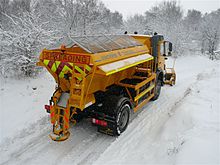Road salt (also known as de-icing salt or snow salt) is a salt used mainly as an anti-slip agent in winter road conditions, but also to prevent dust and snow build-up on roads.[1] Various kinds of salts are used as road salt, but calcium chloride and sodium chloride (rock salt) are among the most common.[2][3] The more expensive magnesium chloride is generally considered safer, but is not as widely used because of its cost and effect on structural integrity.[4][5] When used in its solid form, road salt is often pre-wet to accelerate the ice-melting process.[6]

Spreading
editRoad salt and brine are generally spread using a winter service vehicle called a salt spreader. Salt spreaders are typically added to trucks, loaders, or in the case of brine, tankers. The salt is stored in the large hopper on the rear of the vehicle, with a wire mesh over the top to prevent foreign objects from entering the spreading mechanism and hence becoming jammed. The salt is generally spread across the roadway by an impeller, attached by a hydraulic drive system to a small onboard engine. However, until the 1970s, it was often spread manually either by workers shoveling salt from the back of the truck or by smaller wheelbarrow-like contraptions,[7] the latter still being used today for personal use.[8] Some older spreading mechanisms still require it to be manually loaded into the impeller from the hopper.
Mechanics
editSalt for use of melting ice and snow works through a phenomenon called freezing-point depression, the lowering of a substances freezing point after the addition of solutes. When road salt is added to roads, aside from providing better friction for vehicles on the road, it also dissolves in the water of the ice, resulting in a lower freezing point. As long as the temperature is above this freezing point, this in turn results in the ice melting.[9][10] Because of this, ordinary rock salt is only effective down to a range of −6 to −10 °C (21 to 14 °F). At colder temperatures, it can have the opposite effect. Road salt is sometimes used even in colder conditions, if milder weather is expected. In very cold and dry weather, the road surface becomes rough and the need for de-icing is reduced. However, during extreme cold and rain, the roads can become extremely difficult to pass and, in some cases, roads may need to be closed to traffic.[11]
Types of salt
editSodium chloride
editSodium chloride is by far the most common kind of road salt. This is mainly due to its widespread use and low cost, and thanks to its large industrial infrastructure,[12] it is used in many industrial and consumer applications.[13] While it is common and inexpensive, its effective temperature range usually does not go lower than −6 to −10 °C (21 to 14 °F), and under these temperatures, it is often counter-productive. When used in large quantities, it can also disrupt local ecosystems by heightening the salinity of bodies of water and the soil. Further, rock salt's abrasive nature erodes concrete or asphalt if used heavily.[1][14]
Calcium chloride
editCalcium chloride is less common compared to sodium chloride. While it is slightly more expensive than its sodium-based counterpart, it can cover a far larger area and melts ice almost three times quicker.[15] It has recently started rising in popularity since it is not as environmentally damaging as sodium chloride, and also because of its heightened effectiveness at clearing ice.[16][17]
Magnesium chloride
editMagnesium chloride is more expensive by far than the road salts in common use today. It has a very low environmental impact, and is quite effective at clearing ice. However, it has been discovered that magnesium chloride causes far more damage to concrete surfaces compared to the other salts, and has therefore been largely stopped being used as a de-icer.[4][5] It is still widespread as a dust clearer in warmer weather, and is highly effective at it.[18]
See also
editReferences
edit- ^ a b "Winter is Coming! And with it, tons of salt on our roads". www.epa.gov. 2021-03-08. Retrieved 2024-10-04.
- ^ Rasevic, Paul (2018-10-12). "Comparing Calcium Chloride vs Sodium Chloride for Melting Ice and Snow". Snow & Ice Salt & Chemicals Unlimited. Retrieved 2024-10-04.
- ^ "Calcium Chloride vs. Rock Salt. Which do you use?". Peters Chemical Company. Retrieved 2024-10-04.
- ^ a b "Magnesium Chloride As A Road Deicer: A Critical Review". Peters Chemical Company. Retrieved 2024-10-04.
- ^ a b "Magnesium Chloride - A worse road salt than Calcium Chloride". www.salt.no. Retrieved 2024-10-04.
- ^ "The Trend of Pre-Wetting". SnowEx. Retrieved 2024-10-04.
- ^ Hodgkinson, David (June 2000). "Editorial". Proceedings of the Institution of Civil Engineers - Municipal Engineer. 139 (2): 53–54. doi:10.1680/muen.2000.139.2.53. ISSN 0965-0903.
- ^ "WB Walk Behind Spreaders". Snow Trading. Retrieved 2024-10-04.
- ^ "Why Does Salt Melt Ice on the Roads in Winter?". HowStuffWorks. 1970-01-01. Retrieved 2024-10-04.
- ^ Pollock, Julie. "Salt Doesn't Melt Ice--Here's How It Makes Winter Streets Safer". Scientific American. Retrieved 2024-10-04.
- ^ "Vägsalt - bara där det behövs". Trafikverket (in Swedish). 2024-09-23. Retrieved 2024-10-04.
- ^ "Salt Production and Processing". Morton Salt. Retrieved 2024-10-04.
- ^ Schwartzberg, Ezra (2016-09-27). "The Hidden Costs of Road Salt". Adirondack Research. Retrieved 2024-10-04.
- ^ "Common Types of Road Salt Explained". Ninja De-Icer. 2024-04-08. Retrieved 2024-10-04.
- ^ "Should you use calcium chloride on roads?". Eco Garden Solutions. 2020-09-27. Retrieved 2024-10-04.
- ^ "Road Treatment – Information about Calcium Chloride". Peters Chemical Company. Retrieved 2024-10-04.
- ^ "Calcium Chloride versus Rock Salt". Snow & Ice Salt & Chemicals Unlimited. 2022-06-27. Retrieved 2024-10-04.
- ^ "Magnesium chloride – Salinity". Retrieved 2024-10-04.